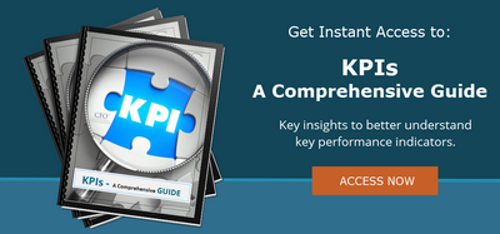
Knowing which KPIs to track is the first step towards financial awareness, but the real goal is to use that awareness to monitor the health of your business and inform intelligent business decisions. Business owners and top-level executives must understand how to use KPIs to formulate a financial analysis that is accurate, actionable, and predictive.
These KPIs should be provided by finance and/or accounting personnel to help bridge the knowledge gap at all levels of an organization. Transparency among business groups regarding key metrics is one of the most commonly recognized ways to effectively monitor business health and meet short and long-term business objectives.
What are 'Key Performance Indicators - KPI'
Key performance indicators (KPI) are a set of quantifiable measures a company uses to gauge its performance over time. KPIs provide a way to measure how well companies, business units, projects or individuals are performing relative to their strategic and operational goals. KPIs can also compare a company's finances and performance against other businesses within its industry.
KPIs can help to reduce the complex nature of organizational performance to a small, manageable number of key indicators which are crucial to decision making and ultimately, to improving performance.
There are many, many KPI’s for every kind of organization. The following are illustrations of some of the more common and ubiquitous metrics.
Monitoring Business Health with Financial KPIs
The most salient functions of finance and accounting professionals are to prepare financial statements (such as the balance sheet and income statement) and do year-end tax preparation, but they should also regularly report on the metrics that matter most to your business. Whether you have an in-house finance team, or use a third-party service to create your financial reporting, you should expect to receive the following on a frequent basis:
- Working Capital KPI
Knowing when you have the money on-hand to pay expenses, fund projects, or invest in the future of the company is of the utmost importance. Cash flow is a critical component of liquidity, which is something that any business seeking funding needs to be aware of as well.
Understanding cash flow includes the working capital KPI. Immediately available cash is known as working capital. The Working Capital KPI is calculated by subtracting current liabilities from current assets, includes assets such as on-hand cash, short-term investments, and accounts receivable and liabilities such as loans, accounts payable, and accrued expenses. The Working Capital KPI creates a picture of your business’s financial health by evaluating available assets that meet short-term financial liabilities.
- Profit and Loss KPIs
Knowing where the break-even point is and whether a business is operating at a profit or loss is something every owner and executive should be cognizant of month over month. Trying to estimate this important figure or waiting until year-end close for an accurate report can result in a business being overextended.
Depending on the type of business, KPIs can include:
- Revenue mix
- Revenue by customer
- Outstanding revenue
- Revenue per Employee
- Operating income
- Profit Increase/decrease year over year
- Cost of goods sold (COGS)
- Profit per product
- Net profit
- Net profit margin
- Current Revenue vs Expected Revenue
Comparing current versus expected revenue and expenses provides a helpful glimpse into whether a business is meeting or falling short of expectations. It also serves to identify areas for improvement early on so that a business can course-correct before the gap between expectations and actuals becomes insurmountably wide.
Current numbers coupled with future business plans should also give a sense of predicted revenue and expense values, to allow for proper long-term planning.
Monitoring Business Health with Operational KPIs
- Payroll
Analyzing payroll costs is an important way to understand one of a business’s most substantial expenses. An accurate value is vital to any business that is considering adding or eliminating personnel because it can determine whether it makes financial sense to do so.
Payroll KPIs can include:
- Cycle time to process payroll
- % of untimely payroll payments
- % of manual payroll payments
- Payroll Recalculation
- # of Payroll errors per month
- # Payroll corrections & changes
- Average hourly pay
- Inventory Turn
While very large companies may report on inventory turn across smaller periods of time like weekly or monthly (based on an annualized calculation), some businesses only examine inventory turnover quarterly or annually. Knowing how much inventory has been sold and shipped within a given period gives a solid basis for projecting sales as well as resource allocation for the coming year.
Monitoring Business Health with Valuation KPI
Those with a technology startup may consider valuation growth to be almost the only KPI necessary. More traditional small businesses will not rely on a valuation KPI but look instead to more immediate KPIs such as monthly recurring revenue. A company valuation can be determined by a finance professional who will take current market conditions into account as well as the business’s existing financial position and valuations of similar companies.
Bridging the Knowledge Gap
Many business owners determine that they cannot justify the expense of a full-time finance or accounting role. However, they may not feel confident that their own financial acumen is advanced enough to handle this responsibility. Without the staff needed to accurately report on and analyze their financial position, these business owners are left wondering whether they are effectively monitoring the health of their companies. This precarious situation can cause turmoil and stymie a business’s growth.
The following solutions help to bridge the knowledge gap while keeping expenses down:
- Buy Software
With the plethora of accounting software options available for businesses across different size classifications, verticals, and growth stages, there is undoubtedly a software to fit your business’s needs. It is a matter of selecting the right one for your needs and experience-level. Researching software may seem daunting, especially to the non-financially-minded business professional, but it can save substantial time and money over the life of the business.
- Outsource Accounting Functions
When it becomes apparent it is time to hire a CFO or controller, you have the option to outsource your accounting and finance functions. By hiring a third-party to perform these functions, you can pay for just what you need when you need it. Furthermore, you do not have to bear the burden of benefits expenses as you would for a full-time employee.
Whether you plan to hire internally or outsource the role, interviewing candidates and third-party companies is a savvy way to discern what you do not yet know. Using the interview process to uncover areas where your knowledge is lacking on the financial topics that matter most to your business is a shrewd learning tactic that any business owner can utilize.
- Attend Financial Training Seminars
If you prefer to handle the finances yourself, attending a training seminar or taking an executive-level class is a great way to expand your financial lexicon. Formal training also presents the opportunity to network with financial experts and professors that can become valuable connections.
- Find a Mentor
Having a professional mentor who brings more business experience to the relationship is beneficial as you progress in your career because he/she can offer the real-world advice that you need. Local business networks and programs can help you find a mentor in your region. In the Pacific Northwest, some of those mentor programs include:
Hiring Professional Assistance
Undoubtedly, the most common solution to bridging the financial knowledge gap is to hire professional third-party assistance. The biggest benefit of outsourcing your business’s financial needs is reduced costs in the form of overhead and technology investments. However, that is certainly not the only benefit. Outsourcing also results in better internal processes and greater efficiency, which are key components for business scalability. Having an outside professional prepare financial statements and offer expert analysis also provides more timely reporting and reliable accuracy.
For emerging professionals, think of key performance metrics as the foundation of your analysis.
Whether you’re an aspiring manager or a seasoned executive, the KPI metrics outlined in our eBook will provide key insights to better understand key performance indicators.







